John Wick: Chapter 4 Stunt Coordinators On The Violent Ballet Of The Movie’s Epic Fight Scenes [Exclusive Interview]
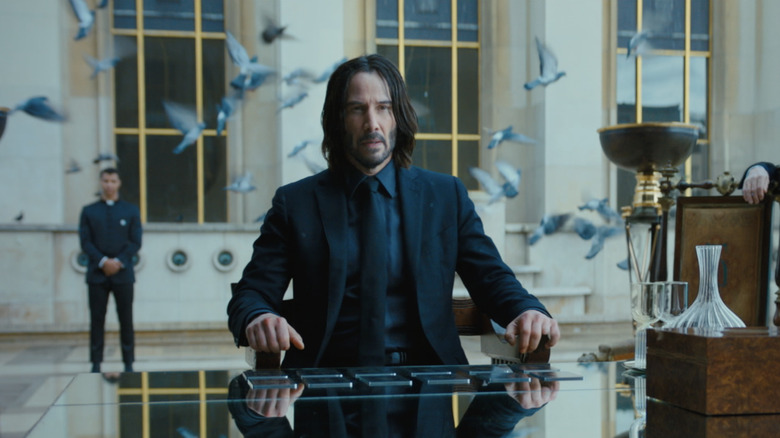
This post contains spoilers for "John Wick: Chapter 4."
To say there are a lot of impressive action sequences and set pieces in "John Wick: Chapter 4" is an understatement. The movie, especially the last hour, is a non-stop assault on your senses as you follow Keanu Reeves' John Wick as he falls out of buildings, gets hit by cars, and falls down way too many flights of stairs.
That stair sequence, it turns out, impressed the stunt coordinators on the film as well. "It was one of the most impressive days of a performer I've ever seen in my 32-year career," Scott Rogers told me when I interview him and his fellow stunt coordinator, Stephen Dunlevy, about their work on "Wick." That long, long fall is one take, and one that "Wick" stunt double Vincent Bouillon did an impressive four times.
I spoke with Rogers and Dunlevy about many other scenes in "John Wick: Chapter 4," including how they had cars hit people safely and what it was like working with Reeves, Donnie Yen, and Hiroyuki Sonata.
Note: This interview has been lightly edited for clarity and brevity.
'Chad Just Challenges You To Do The Best And Take Everything To Another Level'
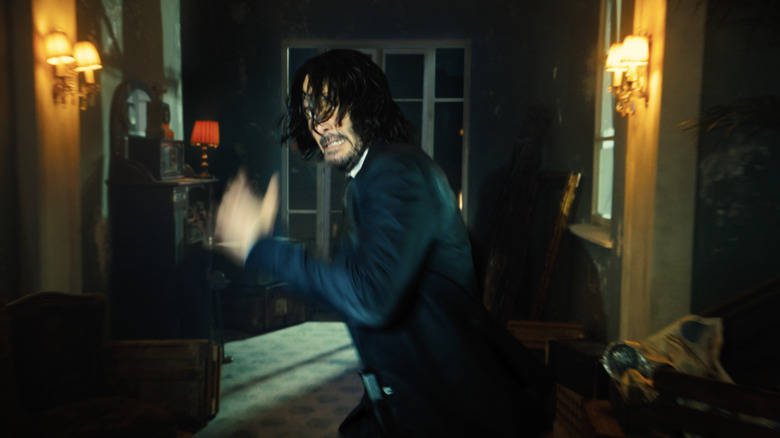
When I talked with director Chad Stahelski, we discussed the top shot scene. One of the things he said was that he likes to find challenges and try to create something cool out of those challenges. So for the top shot sequence, for example, he was talking about how those shots usually don't look good and he wanted to figure out how to make it look good. For you two, were there any other challenges that you wanted to take on and incorporate into this film?
Rogers: I can only speak for myself, and I also did "John Wick 3." Chad and I have been in the business about the same amount of time and he was a top level stunt man. So he comes in and is pushing you to the limit. I've been fortunate to do a lot of really wonderful movies and work with a lot of really talented people. But the "John Wick" world is different than every other world. Chad very seamlessly takes an odd little, pretty simple premise, but then adds on these amazing set pieces. So I don't think I bring a whole lot to it other than saying things like, "I got a scene idea: Let's put John Wick on a horse."
He's already out in front doing that, so you're just trying to keep up and bring the best to what you can in those sequences. Chad just challenges you to do the best and take everything to another level. But he sets the stage, and he sets the scene, and he sets things like that top shot. And the funny thing is — now, I love that shot. And I traditionally hate top shots. I think that's sort of a fighter thing. But I find this scene, the way the camera moves and everything, to be great. We spent a week developing it and I have a background in a lot of wire work with people, but also incorporating camera. So it was a really great opportunity for me to do something that I've spent the last 20 years doing. And then we had to work with a German team that flew the camera and then I could challenge them to go beyond what maybe they've done before, and it really stitched together.
Then we had this amazing French fight choreographer, Laurent [Demianoff], that was developing the choreography. And we had a number of other players, an almost ridiculous number of people that came in. It just becomes fun at some point. I mentioned it earlier — people tell Chad, "That's ridiculous. We can't do that." And he just gets this odd little smile and he's like, "Yeah, we are going to do that, and we're going to add a fire and we're going to add a dog and we're going to add..." So it's fun, but I think ultimately it's Chad leading the way.
'I've Done Stair Falls — You Can Lose Your Perspective Of Where You Are'
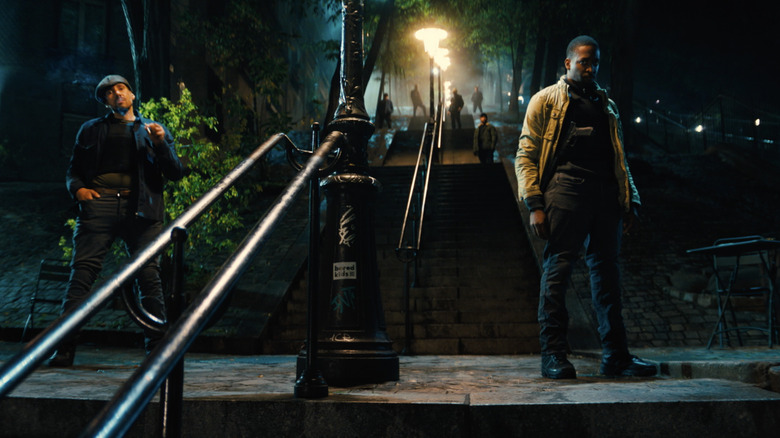
Got it. And I wanted to hear how you worked on pulling the stair sequence together in terms of the choreography of the fights, and then when he gets to the top, that long, long roll down the stairs.
Dunlevy: Well, just sitting at the bottom of those stairs — have you been to the stairs in Monmartre, in France?
No, unfortunately not.
Dunlevy: If you ever get a chance, you should go walk up them — it's a long way up when you're standing there. And Chad's like, "Okay, so this is the sequence, this is what I want to do — he goes all the way up and then he gets kicked down." Thankfully there's levels. So you just take each level, obviously, at a time. You've got to break it up each stunt. With anything we're doing, we're breaking up sections at a time. So we take each level and you build up on top of those levels like a pyramid. And then we had the amazing Vincent Bouillon, our John Wick double, who did that fall all the way down. When you are looking at all that, I think he fell for about two days straight with the different shots in that sequence.
You want to make sure that he can get up after each time. What's paramount, when we're designing a stunt, Scott and I, is obviously our performer's safety because we've both been performers and we've both been hurt and things like that. So we want everyone to go home with maybe a few bruises, a few scrapes, that's just part of the job. But it's making sure we can get up and go again. So when we're doing that, we're talking with the visual effects team about how we can do that safely and design those stunts safely.
Thankfully, with the integration of pads these days — we've got gels that allow us to have smaller pads that protect us more and things like that. Then obviously John Wick goes up and he fights a bunch of guys, Marco [Zaror] kicks him down, and then you have Donnie Yen. We introduced Donnie Yen into that, which is a whole other element of getting to work with Keanu and Donnie, both of them going up the staircase together. We had an amazing fight team. Jeremy Marinas, who truly came up under Chad Stahelski, who was our fight choreographer, he and the team did an amazing job at integrating all those different aspects of the fights all the way through that stair sequence.
You mentioned two days for the fall down. How far did the stunt person go? It wasn't all the way down in one shot, was it?
Rogers: Well, I think there were two sections at the end because there's a shot of a camera leading him and he fell the length of that camera because we couldn't run it longer.
Oh my God.
Rogers: So I think there were two sections of stairs in reality that the camera didn't go down, so he didn't go down those parts. But the full length that you see in the shot, he did four times.
That's amazing.
Rogers: It was one of the most impressive days of a performer I've ever seen in my 32-year career.
I can't believe he did that more than once, either. That's amazing.
Dunlevy: It's not just like we throw someone into a position or anything like that. You're gauging your performers as stunt performers and what they can do in their capabilities. You never want to put someone in a role that's beyond their capability. You always want to have a margin of error. And Scott, you've done stair falls, I've done stair falls — you can lose your perspective of where you are. Not once did Vincent go beyond his ability. He knew exactly where he was on that stair fall. He was in control the whole time, but he went down and he was a master at it. I've never actually seen someone ride the stairs that well before for so far and so long.
It definitely comes across — I'm shocked that was one whole scene going straight. Amazing.
'Ultimately, You're Getting Hit By A Car'
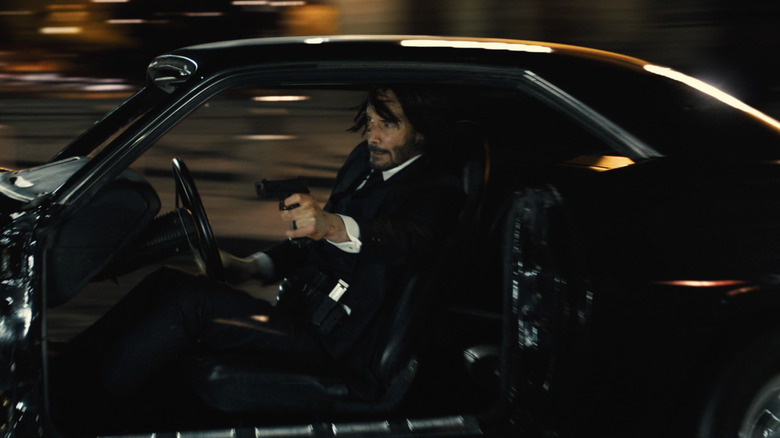
The other scene I thought was really impressive was the car sequence around the Arc de Triomphe. A lot of people get hit by cars. I would just love to understand more about how you safely set that up.
Rogers: Yeah, and now that we're talking about it, I guess that was one of the hardest things, is making sure things are safe. It's "John Wick," and stunt people all want to be on the movie, everybody wants to work on it, wants to do this, but it is dangerous. Ultimately, you're getting hit by a car. We do have the luxury of VFX so we can make padded cars, we can put padding on cars, we can put padding on the ground, and that can protect your brain, but you can still ding your shoulder. We sprained an ankle and one guy hurt his shoulder a little bit, but that was it.
It's a challenge, but we mitigate those dangers by using padding wherever we can. And the drivers of the cars are some of the world's best and they're sliding to a mark. As a fighter, you're getting to this mark and this car's coming to this mark so it looks worse than it is, as long as everybody hits their mark. I'm very proud of the fact that how we did it and what we did and the fact that most everybody walked away unscathed. Like I said, I think we sprained an ankle and we dinged a shoulder. Besides that, everybody walked away, and we did some really big hits.
'Stunt People Dancing Was The Most Dangerous Thing We Did'
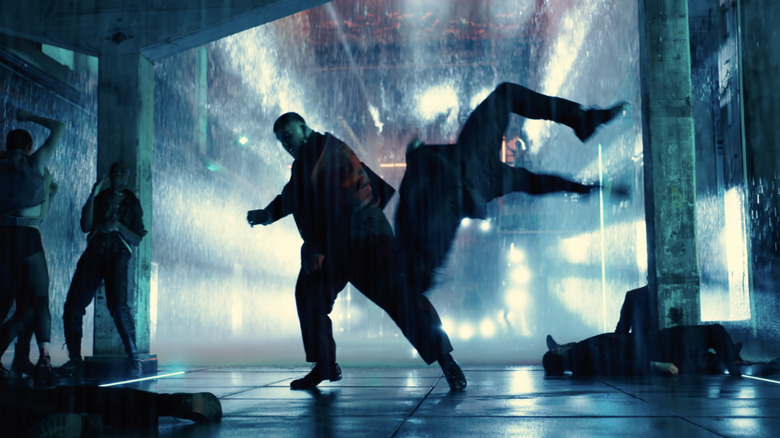
The other scene I would love to hear how it came together is the club scene, because not only are there the waterfalls, but there are dancers. Can you talk about how you accounted for all of that when preparing the sequence?
Rogers: It's layered. We start the prep with the set design. Kevin Kavanaugh, the production designer, designs this amazing set. And early on in prep, we had these curtains of rain and they develop a system for the water to disappear so that we're not fighting in puddles, and so you can move. They make this specific kind of concrete that still had traction. Then we went ... it used to be a famous club in Berlin and it's four stories tall and this rain is coming down all the way from the top. Then the fight team does some fighting in the curtain and you see how that is, and you start piece by piece, and then you got to have a dog and how does that work out here? And where can we put padding?
Then the last level is obviously the extras. You have extras in the background, and then you have stunt dancers -- or there's stunt people acting like they're dancing. Not sure they were very good dancers.
Dunlevy: Stunt people dancing was the most dangerous thing we did. You never know how that's going to work out.
Rogers: Yeah, that's not good. They're much better at getting shot. And then that comes all the way down to the fight itself in the middle. So, those multiple layers and Steve is on set the whole time and making sure all those layers are where they need to be, when they need to be there, and it's no small task, that's for sure.
Dunlevy: I think Scott summed it up pretty well there. Like I was saying before with the stairs, if you see it as a whole, you're like, "Ah!" But it's starting with one small piece — what are we starting with in our center? It's the fights. And then we just build up from there and at any given moment, something could change angles or change locations.
It's being able to adapt and take the modularity of that fight elsewhere. We have our groups of stunt dancers and then we have our professional dancers that are in there that we'll layer around the outside so we can make our stunt guys kind of look good, dancing-wise. Then we build our extras around that, and we have our cushions and our layers to make sure that the people that know what they're doing and the people that can react properly are in the right place.
'That Is One Of The Biggest, Craziest, Most Fun Sets I've Been On In 20-Something Years'
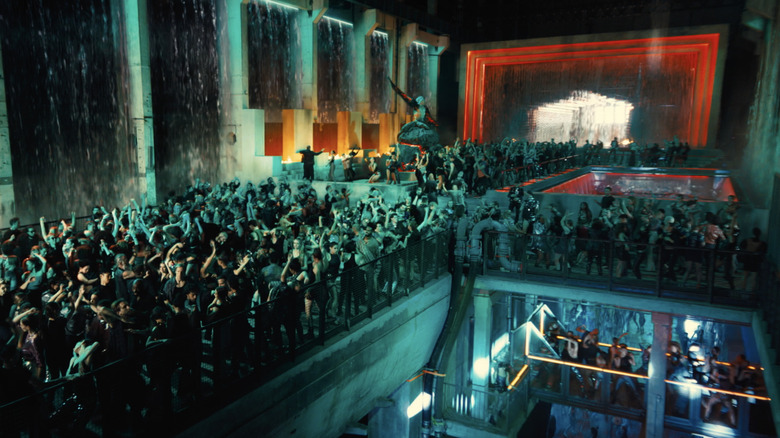
What set pieces were the most challenging to do, that stick out above the rest?
Rogers: I mean the club scene, that water was no joke. There was a lot of water there.
Dunlevy: When you're there as well, with all the lights on and the music and the people dancing, that is one of the biggest, craziest, most fun sets I've been on in 20-something years. The scope of it — you see it on camera, but to be there in person, I wish you could convey how big that was and how much water there was, and the sound and the noise and everything that was going on. They did a pretty good job on camera, but just to be there in person was amazing.
Rogers: Yeah, I really appreciate the other craft that goes into the film, and that scene specifically, the production design of the set, combined with the mechanical effects of how to get the water to do this thing and then just dissipate and look like it's just coming out of nowhere. There's huge, huge hoses, pumping massive amounts of water. The curtain when John Wick walks through, just to watch it live is like, "Oh my god, that's amazing." So the beautiful thing is when you see something live that's that amazing, you're like, "Well, this will be easy to make look good in film," because it already looks stunning.
'Each One Of Them Needed Their Own Distinct Fight Styles'
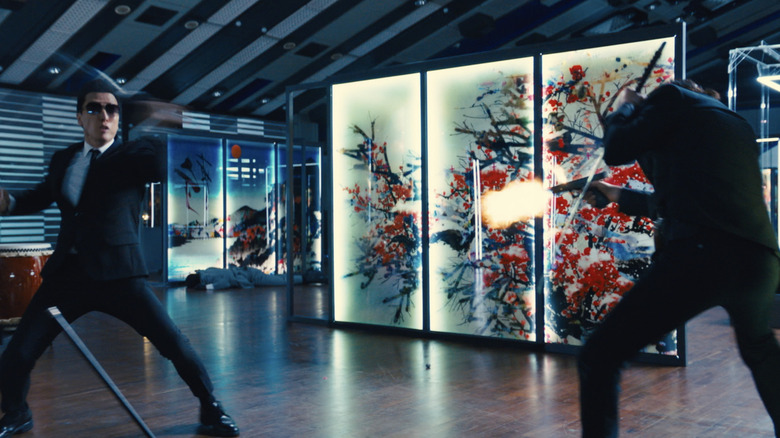
You mentioned the choreography earlier, and for Donnie Yen and Keanu, who are two legends in the action space, what was that like when you had two them together in a fight scene?
Dunlevy: It makes our job very easy when you got someone like Donnie Yen or Hiroyuki Sonata, who come from amazing martial arts and action film genres, working with Keanu, who obviously himself has an amazing background in martial arts, and we're doing the fourth iteration of this.
Keanu sets the standard, like Scott was saying. There's the hierarchy on the call sheet, and he's number one. Keanu's always set a very high standard. He's turning up for training, he's one of the first ones there in the morning. He's training all day in different disciplines. He'll go from working with the fight team in the morning straight to driving or to working with the dogs, things like that. His work ethic is amazing, which set a massive standard. Hiroyuki Sonata and Donnie Yen are no strangers to that, too.
Then we have an amazing fight team with Chad guiding us all the way through with what he wants to see and what he wants to work with. And for Jeremy Marinas, our fight coordinator, to integrate all of those different styles, because everyone is coming in with different skill sets and no two actors or no two characters speak with the same dialogue. So fight styles are unwritten, they're part of the character that Chad builds in, and each one of them needed their own distinct fight styles. To marry those, Chad, in guidance with Jeremy and the fight team, did an amazing job at marrying those fight styles to get a ballet of violence that comes together.
"John Wick: Chapter 4" is now playing in theaters.
Read this next: The Best Action Movies Of 2022, Ranked
The post John Wick: Chapter 4 Stunt Coordinators On The Violent Ballet Of The Movie's Epic Fight Scenes [Exclusive Interview] appeared first on /Film.